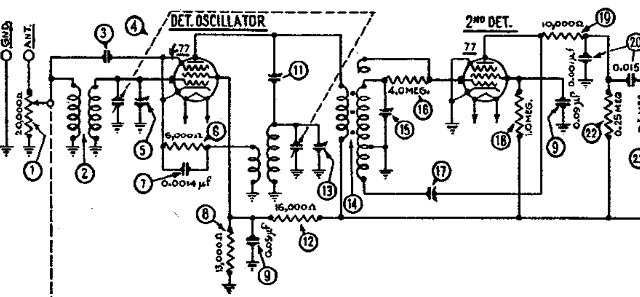08-07-2019, 10:48 PM
The Fluke should be O.K. for the measurements but keep the 260 handy for "sanity" checks.
Old Timers advice, "Any adjustment that doesn't work is broken" Meaning there is an associated coil that is tuned by the trimmer, that coil is probably open or there is a poor connection, somewhere...
If you have dud tubes of the same pin configuration laying about, take some very coarse sandpaper to the pins and sand them well. That makes the pins very rough. When the dud tube is plugged in repeatedly, the roughness will clean oxidation from the very sides of the tube socket contacts where it counts.
Most of the antenna coil oscillator and IF coil resistance will be very low, most not over 30 ohms. If the resistances are up, that coil is suspect of being open.
The 260 can be used to do leakage between the windings in the high ohms settings. There should be zero leakage. Any leak between windings is a defective coil.
Most of Philco coils from this era can be rewound, it is a project to get it right...
I suspect the radio has some underlying fault that caused a previous mechanic to run amuck. That fault will be hard to find, remember to suspect any mechanical connection. After all these years the cadmium or zinc plating gets oxidized even on parts in intimate contact. It is those connections that get overlooked.
The 260 set to low ohms may reveal a bad mechanical joint as it is passing current through that the Fluke may not.
Begin with a look at the unresponsive trimmer.
Then get all the voltage readings looking for errors, correct them.
Re-align the set and see where it is at. Follow the advice in my first post...
Still "dead" then some means to inject signal is needed.
However, this is a three tube radio and only two tubes are actually "radio" the third is an audio amp...
GL!
Chas

Old Timers advice, "Any adjustment that doesn't work is broken" Meaning there is an associated coil that is tuned by the trimmer, that coil is probably open or there is a poor connection, somewhere...
If you have dud tubes of the same pin configuration laying about, take some very coarse sandpaper to the pins and sand them well. That makes the pins very rough. When the dud tube is plugged in repeatedly, the roughness will clean oxidation from the very sides of the tube socket contacts where it counts.
Most of the antenna coil oscillator and IF coil resistance will be very low, most not over 30 ohms. If the resistances are up, that coil is suspect of being open.
The 260 can be used to do leakage between the windings in the high ohms settings. There should be zero leakage. Any leak between windings is a defective coil.
Most of Philco coils from this era can be rewound, it is a project to get it right...
I suspect the radio has some underlying fault that caused a previous mechanic to run amuck. That fault will be hard to find, remember to suspect any mechanical connection. After all these years the cadmium or zinc plating gets oxidized even on parts in intimate contact. It is those connections that get overlooked.
The 260 set to low ohms may reveal a bad mechanical joint as it is passing current through that the Fluke may not.
Begin with a look at the unresponsive trimmer.
Then get all the voltage readings looking for errors, correct them.
Re-align the set and see where it is at. Follow the advice in my first post...
Still "dead" then some means to inject signal is needed.
However, this is a three tube radio and only two tubes are actually "radio" the third is an audio amp...
GL!
Chas
Pliny the younger
“nihil novum nihil varium nihil quod non semel spectasse sufficiat”



![[-] [-]](https://philcoradio.com/phorum/images/bootbb/collapse.png)


